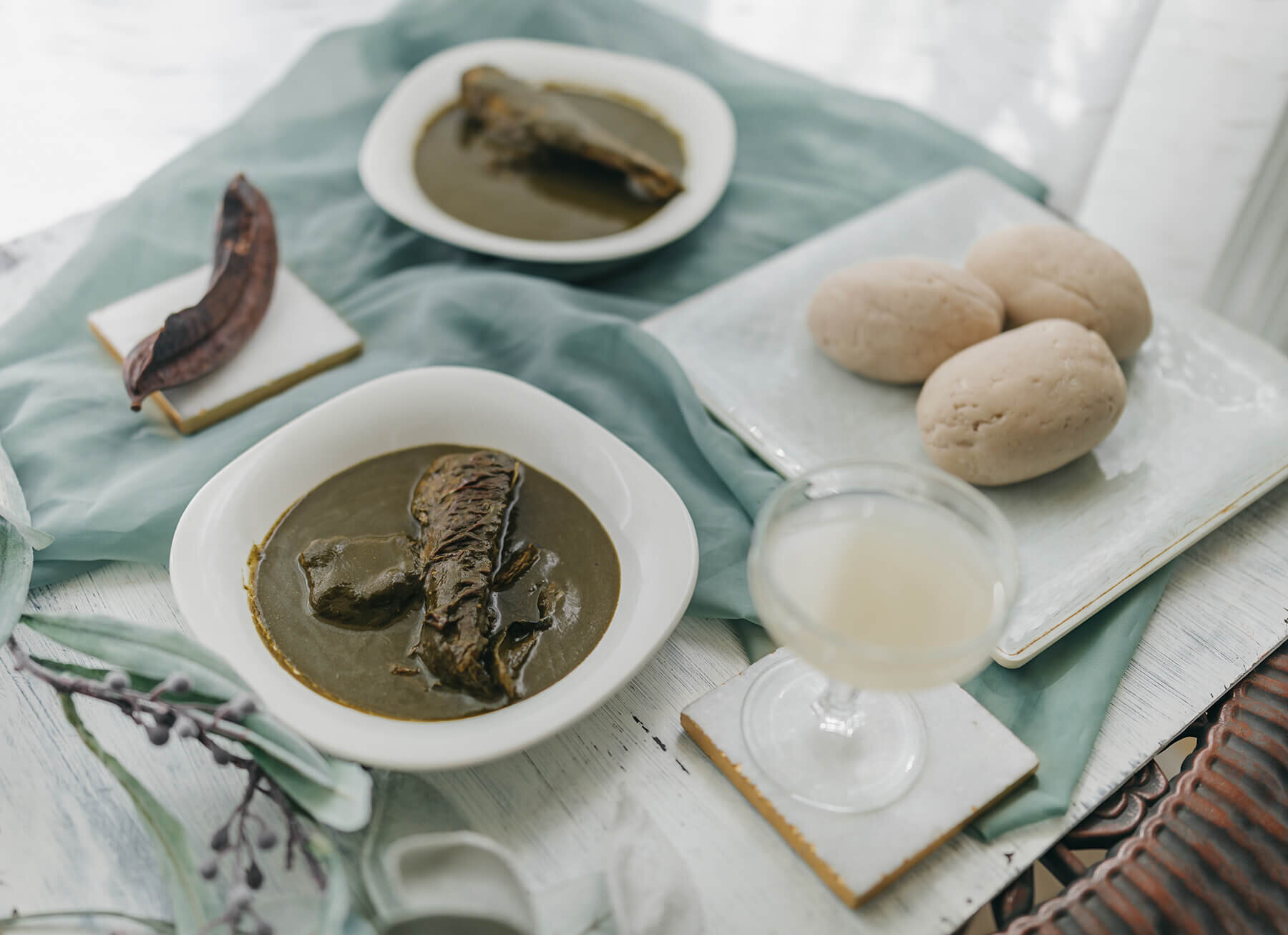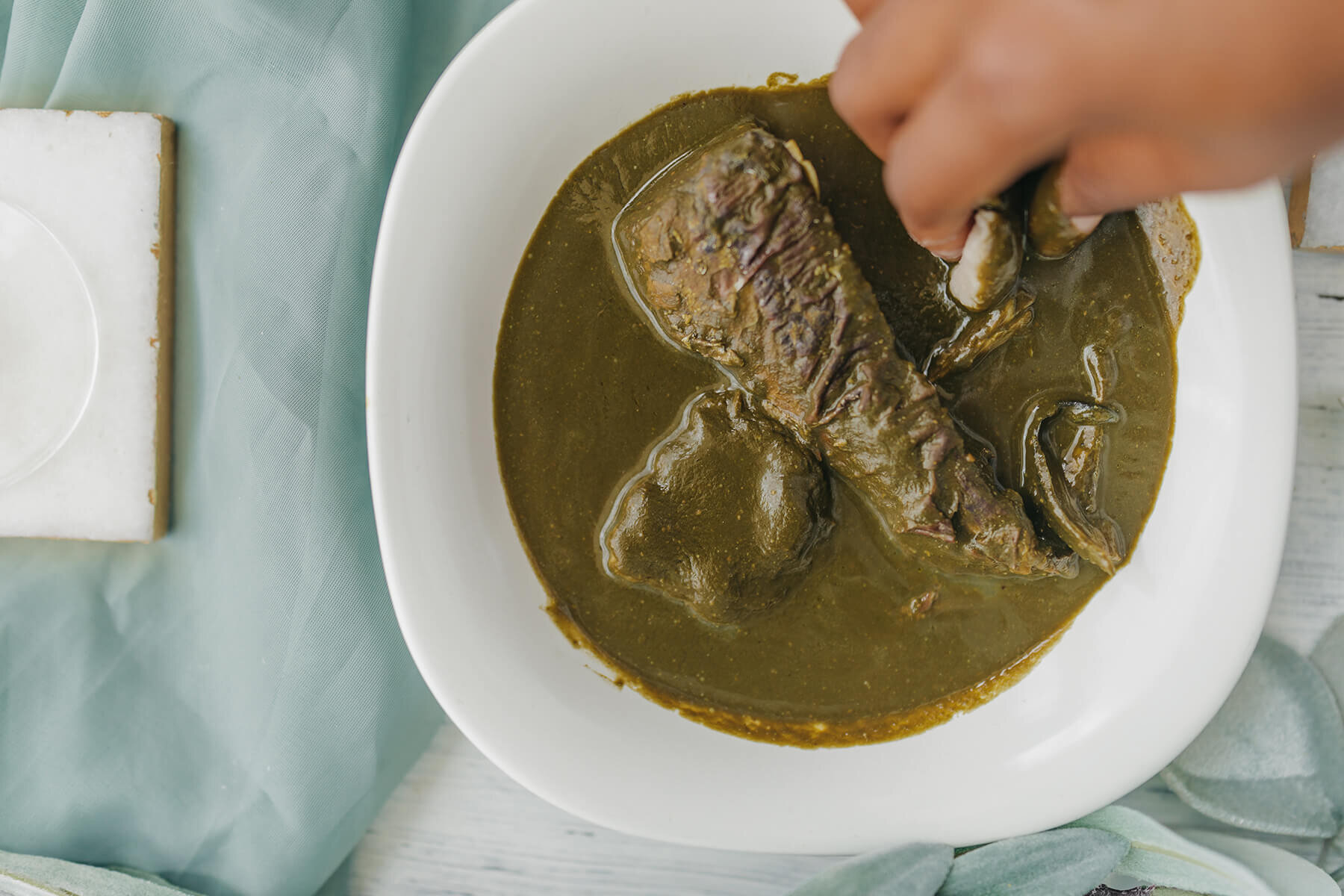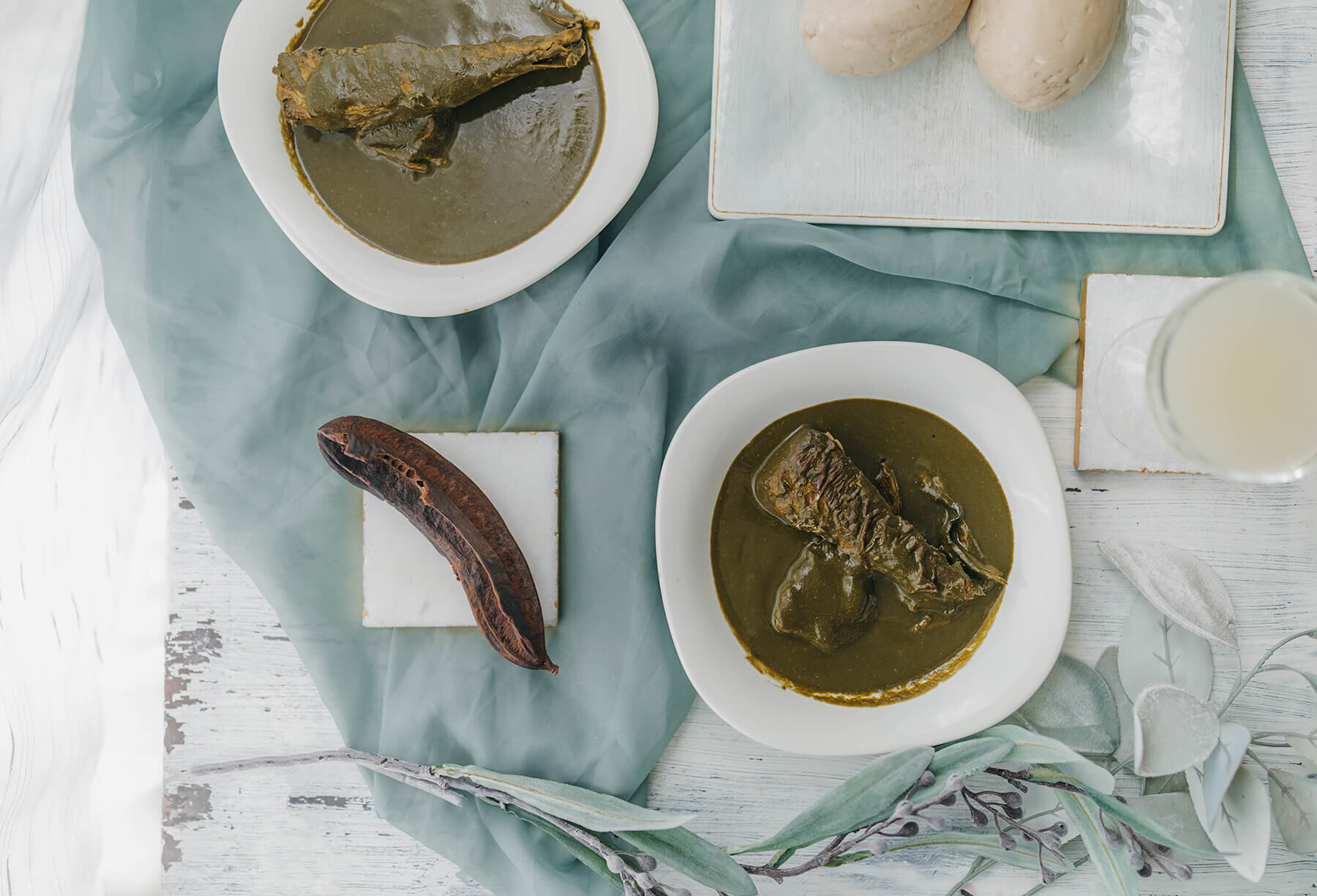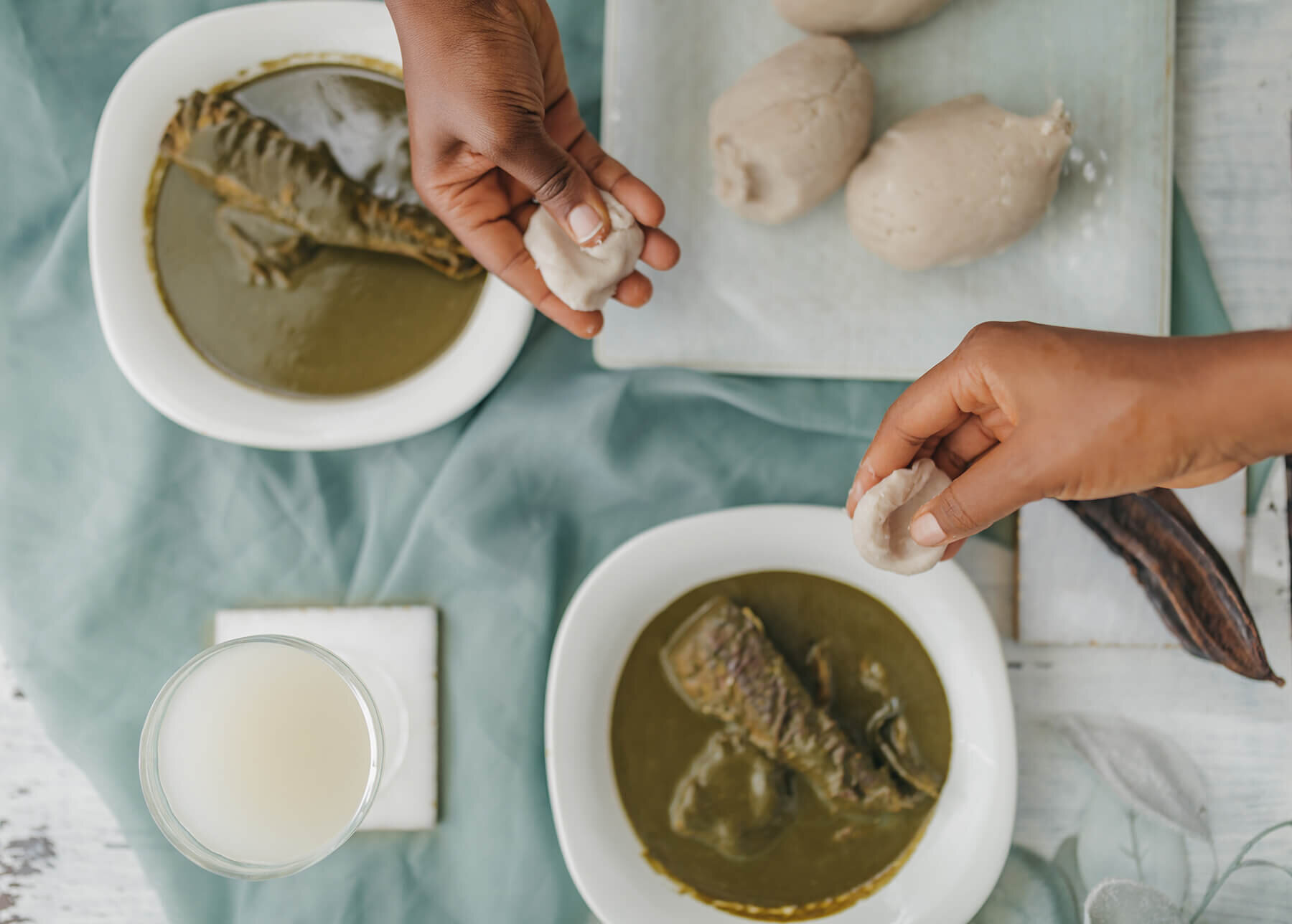Kwanmkwala and Esubag Recipe
Á bè-lóbé óh sóó
“People, let’s sing praise”
óh sóó, óh sóó, óh sóó, óh sóó, óh
“Let’s sing praise”, let’s... praise
Á sé mèyèngè
“We are happy”
Á sé mèyèngè,
“We are happy”
Á sé mèyèngè,
“We are happy”
I come with good tidings into the land of Mount Kupe Mwanenguba to celebrate the country chop that got its name from the rhythm of a pestle and a mortar. I watched how the pestle in the hands of Mami Ahone moved in an up, down, front, back, and circular motions in the mortar to grind cooked Igbo cocoyam leaves into a soft puree. We ate this puree with cocoyam fufu at the CDC Cottage Hospital Staff Quarters in Tiko. That was almost 29 years ago.
Mami Ahone hails from the Bakossi tribe in the land of Mount. Kupe-Mwanenguba and Mt Nlonako in Kupe-Muanenguba Division of Cameroon. The Bakossi land has an equatorial climate that is characterized by a heavy rainfall that lasts throughout the year. This gives rise to a fertile soil that is favorable for the growth of cocoyams. For many years, Kupe-Muanenguba Division continued to be one of the largest producers of cocoyams in the Southwest Region of Cameroon. Out of the abundance of cocoyam plants comes varieties of Bakossi traditional dishes (Esubag, Nzab-Ngen, AlleMpub, Kwanmkwala, and many more).
Mami Ahone, a keeper of the Bakossi culture and cuisine made it possible for us (her neighbors) to eat these Bakossi traditional delicacies. The thundering sound coming from the pestle when it collides with the mortar was a public service announcement that cooking has commenced in Mami Ahone’s kitchen. There were two sounds that travelled through the open doors and windows in her Kitchen. The First sound “Thump! Thump!” meant she was making Esubag (Cocoyam Fufu). The second was a “Grinding” sound with a unique rhythm that meant Mami Ahone was cooking one of the Bakossi traditional soups made with cocoyam leaves. What was this “Grinding” sound with a unique rhythm? In my quest to learn more about the culinary culture of the Bakossi tribe, I was privileged to have an informative conversation with Mommy Emade who is one of the mothers of Keng’s Kitchen and a native from the Bakossi tribe. During our conversation, I captured an organic moment. She said “...when you grind the cocoyam leaves in the mortar, the traditional way, the movement of the pestle in the mortar makes this sound Kpangkpanglang! Kpang! Kpang! Kpanglang. It's from this rhythm that our ancestors named the dish. what we call today as Kwanmkwala...”
I can confirm to you that the smooth texture of the cocoyam fufu, the flavors from the indigenous African spices in the Kwanmkwala all blended with the magic that happens in the Mami Ahone’s mortar gave us a mouth watering and finger licking experience which I cherish to date. Click play on the video below to cook along with me or scroll past the video to follow the written instructions.
Dish: Kwanmkwala and Esubag
Country: Cameroon
Geographic Location: Southwest Region
Ethnic Groups: Bakossi
Diaspora Connection: Bakossi Cultural & Development Association
K W A N M K W A L A A N D E S U B A G
Ingredients
1 Pound Igbo Cocoyam leaves
1 Teaspoon Country Onion
1 Teaspoon Bush Pepper
1/4 cup Njangsang
Small Piece of Four Corner Spice
1 Pound Smoked Fish Mackerel or a Fish of Choice
1 Pound Smoked Lamb or a Meat of Choice
2 Habanero Peppers
Bouillon
Salt
Preparing the Esubag (Cocoyam Fufu)
Please Note: Direct skin contact with raw cocoyams may cause itchiness for some people. It is advised to wear rubber gloves when completing the following steps.
1. Peel the cocoyams and wash thoroughly then place into a pot and add water. The level of water should reach the height of the potatoes halfway then cook the cocoyams on medium heat. Gradually add water as needed to fully cook the cocoyams then turn the stove to warm.
Note: It is important for the Cocoyams to stay warm for pounding.
Boil cocoyams.
2. Transfer the cocoyam into the food processor and blend until it's soft then transfer the fufu dough into a bowl. Mix the fufu by folding the dough inwards until it forms into a mold.
Note: Traditionally, the process is done by pouding the cocoyams in a mortar.
3. Scoop about a fist of the fufu dough and wrap with a parchment/plantain or Banana Leaves/ Fuel Paper/ Plastic Wrap paper and set aside.
Preparing the Kwanmkwala (Cocoyam Leaf Soup)
1. Thoroughly wash the cocoyams leaves, remove the veins and place the leaves into a pot. Add a cup of water and cook the cocoyam leaves on medium heat until it becomes soft.
Boil cocoyam leaves.
2. Add the njansang, habanero peppers, and four corner spice into the pot. Mix well and allow to cook on medium heat. Observe the pot while it’s cooking and add ½ a cup of water at a time if needed to prevent the leaves from burning. Continue cooking the leaves until they become slightly brownish in color which indicates that the leaves are done. Turn off the stove then set the pot aside to cool for a later use.
Note: Uncooked or partially cooked cocoyams leaves can cause allergic reactions. Therefore, ensure that the cocoyams leaves are thoroughly cooked before using it to prepare the soup. Fresh or frozen Spinach is a great substitute for individuals with known allergies or when cocoyams leaves are not available in the market.
3. While the pot of cocoyam leaves is cooling, wash the smoked meat thoroughly and place it into a pot. Add bouillon, salt and enough water to cover the level of the meat in the pot and allow it to simmer on medium heat.
4. When the meat is 75% cooked, add the smoked fish into the pot and allow it to cook on low heat until the meat is done with at least 3 cups of stock left in the pot.
Boil smoked meat and fish.
5. Pour the cooked cocoyams leaves mixture into the blender and blend on high speed until the mixture forms in a soup.
6. Pour the cocoyam leaf soup into the pot containing the meat and fish. Add the country onion, bushpepper, and adjust the taste with salt and bouillon to your preference. Stir gently for all ingredients to combine and cook on low heat for 15 minutes.
7. Serve the kwanmkwala with the Esubag on the side and enjoy!













